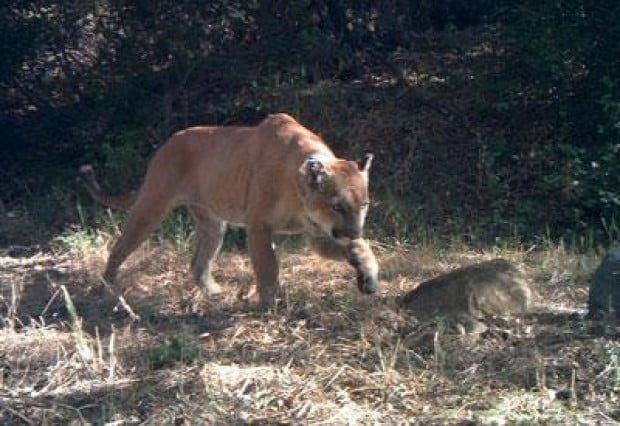
Loss of habitat, and recently, poaching, has led to a decline of the mountain lion population in the Santa Monica Mountains.
By McKenzie Jackson / Special to The Malibu Times
The Santa Monica Mountains surrounding Malibu are home to a big cat that has seen its population numbers decrease within the last decade.
The 40-mile mountain range that stretches along the Pacific Coast is the home of mountain lions, the largest predator in the local wilderness. Dr. Seth Riley of the National Park Service, which is in the 10th year of a project studying the mountain lion, said their population in the mountain range has decreased because of urbanization and territorial fights.
“A loss of habitat is probably the biggest issue,” said Riley, who works with the Thousand Oaks-based NPS as a Wildlife Ecologist. Riley said loss of habitat leads to male mountain cats killing each other over “home range,” which is the animal’s hunting and mating grounds.
Over the past 10 years, the NPS has tracked 21 mountain lions in the Santa Monica Mountains, which stretches east to west from the Hollywood Hills to Ventura County and north to south from the San Fernando Valley to West-Central Los Angeles. The mountains separate Malibu from the San Fernando Valley.
NPS believes there to be four to eight mountain lions that call the local mountains home.
“We are radio tracking two in the Santa Monicas and we know through remote camera surveys of at least two more,” Riley said. “It could certainly be more than that, maybe twice that. Based on everything we’ve seen the last 10 years, there is not enough room in the Santa Monica Mountains for more than 10 or 15 mountain lions.”
Riley said the mountain lion, which can be found in areas from South America to Canada, is not endangered as a species, but is having trouble surviving in the urban landscape of Los Angeles.
“They really can use a lot of space,” he said. “One male can use the entire Santa Monicas and that is not a big home range, particularly for a mountain lion if you compare it to other places. Large carnivores like mountain lions are affected detrimentally by roads and development because they need so much space. The population of mountain lions in the Santa Monicas is one that is at risk.”
Mountain lions are one of several carnivores in the Santa Monica Mountains that NPS studies along with bobcats, gray foxes, coyotes, raccoons, badgers and ringtails. However, mountain lions have come to the forefront recently due to some of the large predators being killed.
On September 11, the carcass of a 7-year-old male mountain lion was found mutilated in a canyon between Cal State Channel Islands and Newbury Park in Ventura County. Tissue samples from the animal confirmed that it was a mountain lion that was being tracked by NPS named P-15. The tracking collar was also taken from the creature’s body. No suspects have been apprehended in the case.
One month earlier, a 15-month male mountain lion being studied by NPS, named P-18, was hit and killed by a car while trying to cross the 405 Freeway near the Getty Center.
P-18 was the second cougar to be killed in three years on the southbound 405.
At a December meeting of the Santa Monica Mountains Conservancy, Riley discussed the plight of mountain lions and the work NPS has been doing with the creatures. He also updated the conservancy’s board on a multi-year 405 Freeway project NPS is conducting.
“We are monitoring wildlife crossing in the Sepulveda pass area,” he said. “We are monitoring four crossing points. We are monitoring them for wildlife use and what animals are going across the freeway.”
Riley said interstates and other roadways are somewhat hindering the mountain lions’ population growth.
“Major highways that isolate those natural areas from each other,” he said. “That is a major issue with carnivores or mountain lions.”
Riley said the loss of habit also forces more male mountain lions to come in contact with each other and battle over their home range.
“They are pretty territorial animals,” he said. “They are large carnivores, so they kill large prey. They mostly eat deer. So, they need a big enough source of deer in their home range. But it seems like with the males in particular that have these really large home ranges. And they end up having negative interactions with other males.”
Riley said due to being hemmed in by the ocean and roadways, there is a possibility that the animals could begin inbreeding in the future, which could lead to biological defects and abnormalities.
“The lions in the Santa Monicas have less genetic diversity than animals in the rest of the state,” he said.”We haven’t seen evidence of inbreeding yet, though.”
